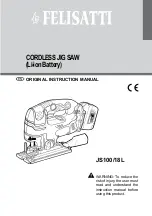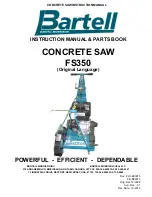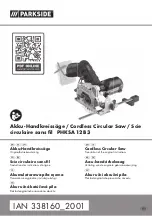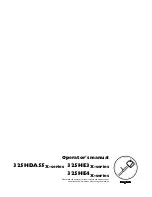
www.scheppach.com /
+(49)-08223-4002-99 /
+(49)-08223-4002-58
30 | GB
• Loosen the sawband when the machine is not in
operation (e.g. after finishing work). Attach a notice
on the tension of the saw band to the machine for
the next user.
• Collect unused sawbands and store them safely in
a dry place. Check for faults (teeth, cracks) before
use. Do not use faulty sawbands!
• Wear suitable gloves when handling sawbands.
• All protective and safety devices must be securely
mounted on the machine before beginning work.
• Never clean the sawband or the sawband guide
with a hand-held brush or scraper while the saw-
band is running. Resin-covered sawbands impair
working safety and must be cleaned regularly.
• For your own protection, wear protective glasses
and hearing protection. Wear a hairnet if you have
long hair. Roll up loose sleeves over the elbows.
• Always position the sawband guide as near the
workpiece as possible when working.
•
Insure sufficient lighting in the work area and
around the machine.
• Always use the fence for straight cuts to keep the
workpiece from tipping or slipping away.
• When working on narrow workpieces with manual
feed, use the push stick.
• For diagonal cuts, place the saw bench in the ap-
propriate position and guide the workpiece on the
fence.
• In order to cut dovetail tenons and teeth or wedges,
swivel the saw table into the plus and minus po-
sition. Ensure that the workpiece is guided safely.
• For arced and irregular cuts, push the workpiece
evenly using both hands with the fingers together.
Hold the workpiece with your hands on a safe area.
• Use a pattern for repeated arced or irregular cuts.
• Insure that the workpiece does not roll when cutting
round pieces.
• For safe work when transverse cutting, use the
special transverse cutting gauge accessory.
10.1 Performing longitudinal cuts (Fig. AD)
Here, a workpiece is cut in its longitudinal direction.
• Position the longitudinal fence (5) on the left side (if
possible) of the saw band, in accordance with the
desired width.
• Lower the saw band guide (4) onto the workpiece.
(8.9)
• Switch on the saw.
• Press one edge of the workpiece against the longi-
tudinal fence (5) with the right hand, whilst the flat
side lies on the saw bench (7).
• Slide the workpiece at an even feed rate along the
longitudinal fence (5) into the saw band.
• Important: Long workpieces must be secured
against tipping at the end of the cutting process
(e.g. with reel-off stand, etc.)
• Attention! When processing narrower workpieces it
is essential to use a push stick.
8.10 Transverse cutting gauge (14)(optional) (Fig.
AC)
• Slide lateral stop (aj) into a groove (af) in the saw
bench.
• Release the grip screw (ag).
• Turn the lateral stop (aj) until the desired angular
dimension has been set. The arrow on the lateral
stop indicates the set angle.
• Retighten the grip screw (ag).
• The stop rail (ai) can be slid against the lateral
stop (aj). To do so, loosen the knurled screws (ah)
and slide the stop rail (ai) into the desired position.
Tighten the knurled screws (ah) again.
• Attention! Do not slide the stop rail (ai) too far in the
direction of the saw blade.
8.11 On/Off switch (Fig. A)
• To turn the machine on, press the green button
„1“ (10). Before starting sawing, wait until the saw
blade has reached its maximum speed.
• To turn the machine off again, press the red button
„0“ (10).
Attention!
When working with the machine, all protective devic-
es and guards must be fitted. The upper and lower
bandwheel is protected by a fixed guard and an artic
-
ulated cover. When opening the cover, the machine
is switched off. Starting is possible only with closed
cover.
9. Transport
Caution: Pay attention to the weight of the machine
when lifting it and call upon the help of another per-
son!
Use the transport equipment. Stand on the side of the
wheels. Pull the upper part of the machine towards
you so that the machine stands on the two wheels
and can be moved. Hold the machine by its frame (9).
Attention! Note the high centre of gravity of the
machine.
Attention! Never use separating safety guards to
lift or transport the unit.
10.
Working instructions
The following recommendations are examples of the
safe use of band saws.
The following safe working methods should be seen
as an aid to safety. They cannot be applied suitably
completely or comprehensively to every use. They
cannot treat every possible dangerous condition and
must be interpreted carefully.
• Connect the machine to a suction unit when work-
ing in closed rooms.
















































